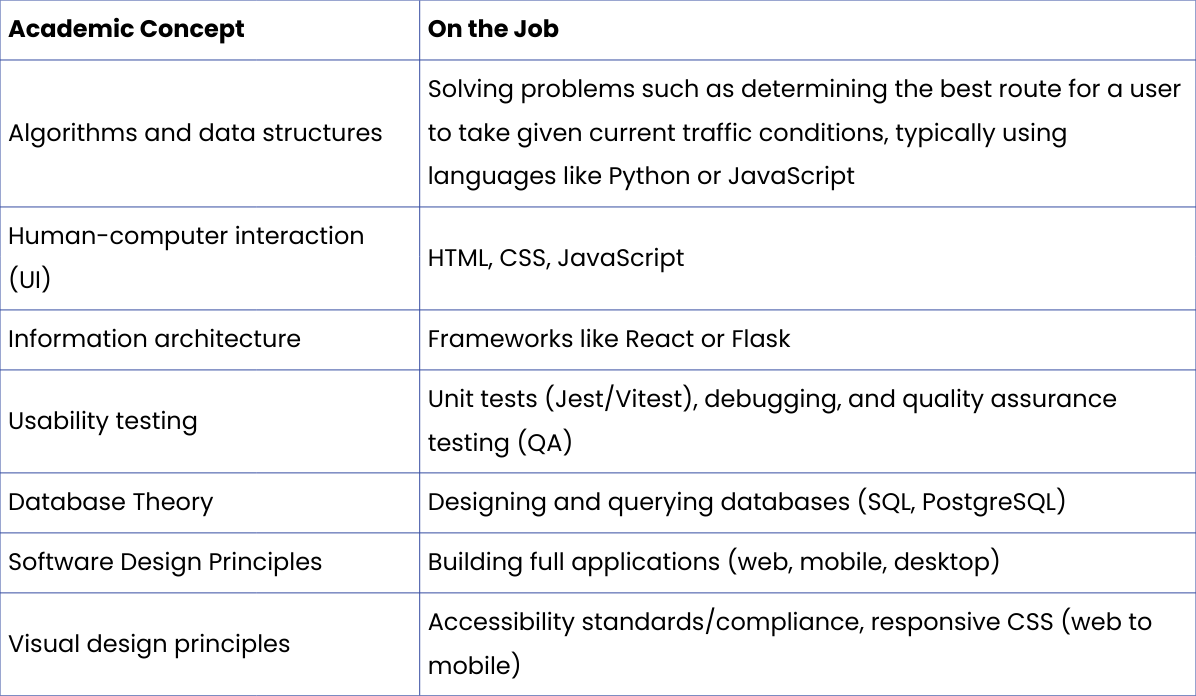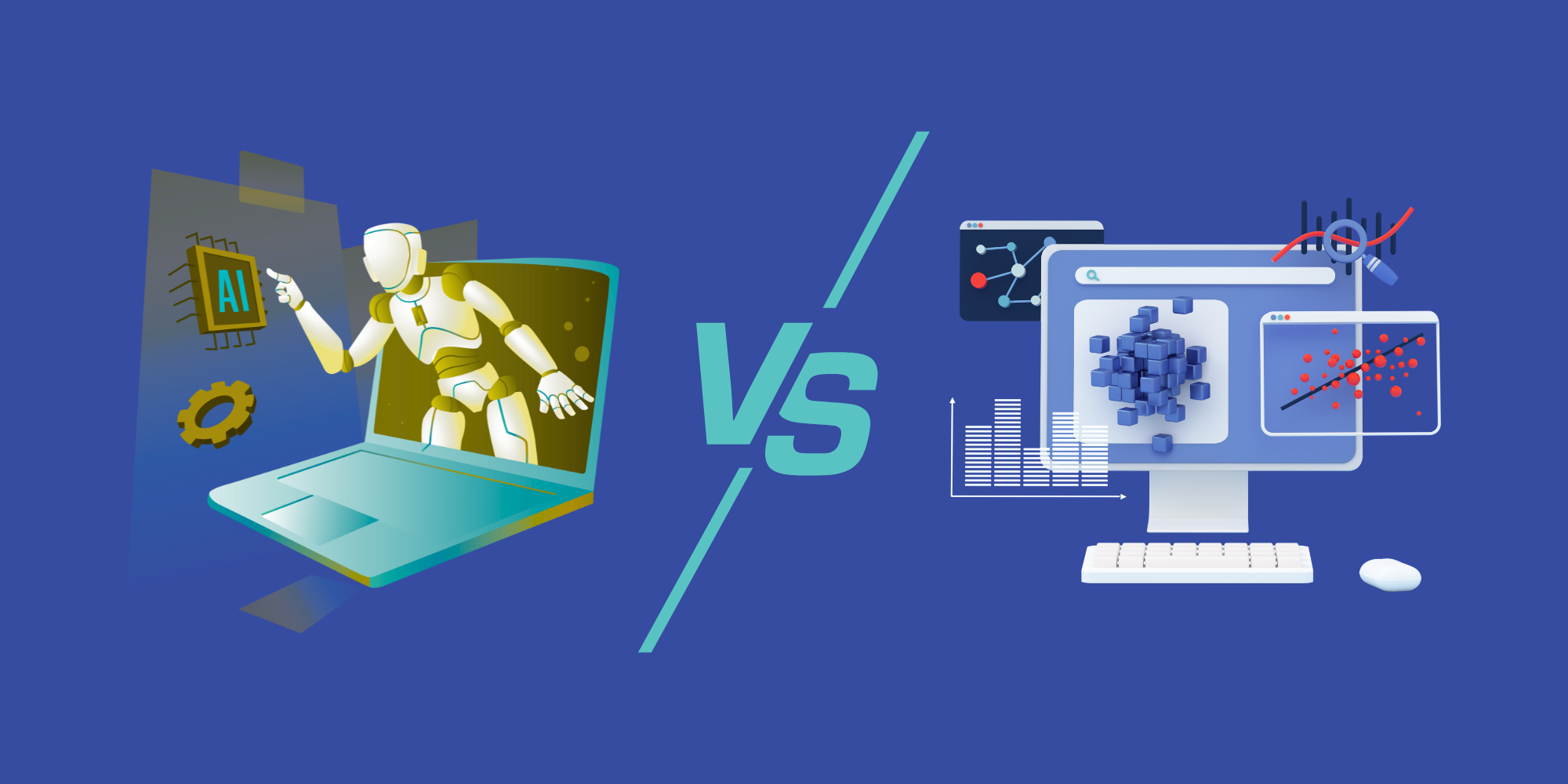As both a former Software Engineering student and now an educator and curriculum writer, I’ve seen how intimidating the term “software engineering” can sound to newcomers. At its core, software engineering is about learning to think like a builder and creating stories. Whether you’re designing an intuitive front end or creating the logic that runs behind the scenes, you’re using creativity, logic, and empathy to make technology that serves people, and hopefully, having a lot of fun coding along the way!
In this post, we’ll break down what software engineering really means, explore what front-end and back-end developers do, and show how these roles power nearly every industry. By the end, you’ll have a clearer picture of how software engineers shape the digital world and how you can start learning the skills to join them.
What is Software Engineering?
Software engineering is a sub-discipline of computer science that focuses on the design, development, testing, and maintenance of computer programs. It uses systematic approaches, often compared to traditional engineering, to ensure that software is reliable, efficient, and meets user needs. A software engineer is someone who applies programming skills to build real applications, such as websites, mobile apps, cloud platforms, and business tools. Job titles include Software Engineer, Application Developer, Backend Engineer, Full Stack Developer, and Mobile Engineer. These professionals combine technical knowledge with problem-solving to create tools people use in their daily lives.
What is a Front End Developer?
Front-end development is a branch of software engineering focused on the parts of a website or application that people see and interact with. It draws from computer science concepts like human-computer interaction and information design. A front-end developer creates user-facing applications using programming languages such as HTML, CSS, and JavaScript. Common job titles include Front End Developer, Web Developer, UI Developer, React Developer, or JavaScript Engineer. These professionals focus on making digital products not only functional but also usable and visually clear.
What is a Back End Developer?
Back-end development is the study and practice of server-side computing. It focuses on how data is stored, processed, and delivered to users. Core topics include databases, algorithms, networking, and system design, all of which ensure that applications run securely and efficiently. A back-end developer builds and maintains the “behind-the-scenes” systems that power applications. While users interact with the front end, the back end manages databases, servers, and application logic. Common job titles include Back End Developer, API Engineer, Database Developer, Cloud Engineer, or Software Engineer (Backend). These professionals work with tools like Python, SQL, and Flask to make sure that when you click a button on a website, the right information is delivered quickly and safely.

Where Software Engineering is Used
Software engineering is one of the most widespread and important fields in the world today. Every industry depends on software to operate. Without engineers, businesses and organizations would not have the digital systems needed to run daily tasks, connect with customers, or manage information. Engineers are the “builders” of the digital age, making sure technology actually works for people. Because of this, software engineers are employed across almost every industry and sector.
Examples include:
- Government: Developing secure systems for managing public records and services.
- Healthcare: Building electronic health record systems and telemedicine platforms.
- Finance: Creating tools for online banking, trading, and fraud detection.
- Education: Designing learning management systems and classroom technology.
- Retail: Powering e-commerce websites and mobile shopping experiences.
Where Front-End Development is Used
Front-end development is the most visible part of software engineering to end users. Every website, mobile app, or digital tool that people use has a front end, the part that users see and click on. Without front-end developers, the internet would be a collection of raw data with no way for people to interact with it. These professionals bring design and function together, turning ideas into tools that feel simple and natural to use. Because of this, front-end skills are in demand across nearly every industry. From checking your bank balance online, to booking a doctor’s appointment, to shopping on your favorite site, a front-end developer built the experience. In many ways, they are the “bridge” between technology and people, making sure that complex systems can be understood and used by anyone. Front-end developers are found in nearly every industry:
- Healthcare: Creating patient portals that are easy to navigate for patients and providers while following HIPAA.
- Finance: Building secure and intuitive banking dashboards to provide users with a quick, up-to-date understanding of their financials.
- Retail: Designing e-commerce sites that improve shopping experiences and give consumers a real-time view of current stock, their cart, and order history.
- Non-Profit: Developing accessible websites to share resources with the public.
- Social Media: Creating aesthetic and smooth user experiences that cause users to continue to scroll through posts.
Where Back-End Development is Used
Back-end development is everywhere, powering the invisible parts of digital life. While users only see the front end, every click, login, and purchase is supported by back-end systems that move data behind the scenes. Without back-end developers, apps would look nice but couldn’t actually “do” much.
Examples across industries include:
- Healthcare: Running secure patient databases and telehealth platforms.
- Finance: Powering online banking systems, user authentication, security, and fraud detection tools.
- E-commerce: Managing inventory, shopping carts, and payment processing.
- Government: Handling secure records, tax systems, and online services.
- Entertainment: Delivering high-quality streaming services that handle millions of users at once.
- Social Media: Creating secure user authentication, storing an ever-growing amount of data, and designing algorithms to keep users engaged and viewing content.
Back-end developers are critical because they build the infrastructure that makes modern technology possible.
Frameworks and Methodologies
Developers rarely build everything from scratch. Instead, they use proven methods and frameworks to work faster and create reliable results. A framework is like a blueprint: it gives developers a set of pre-built tools or rules that guide how an application should be structured. A methodology is more about the process: it explains how developers should approach their work, from planning to testing. Together, these help teams stay consistent, solve problems, and deliver high-quality applications on time. Our curriculum focus on industry standards that employers expect junior developers to know. By learning these, students not only understand the “how” and “why” of front-end work but also practice building projects in the same way professional engineers do every day. Some of the frameworks and methodologies we teach include:

Prerequisite Knowledge
If you’re interested in exploring SMU x Flatiron Tech Bootcamps in Software Engineering as a next step, note that our students do not need prior coding experience but refreshing on the following would be helpful:
- Basic computer literacy (file management, browsers, copy/paste)
- Logical thinking (breaking problems into small steps, like putting together a PB&J sandwich or writing recipes with as much clarity as possible)
- Introductory math (variables, order of operations, simple graphs)
Conclusion
Writing code isn’t only about logic or problem-solving; it’s about creativity, curiosity, and that rush you feel when something you built finally works. Yes, programming can be challenging, but that’s part of what makes it so rewarding. It’s the satisfaction of seeing your ideas come to life on screen and realizing that you can shape the digital world around you. Every bug you fix or feature you finish is a small victory, proof that you’re learning to think in new and exciting ways.
We teach students the same tools and frameworks used by professional developers (JavaScript, ReactJS, Python, Flask, and more) while emphasizing the mindset that makes great engineers: curiosity and persistence. We don’t just teach students how to code. We want to help them discover why coding can be so much fun! If you’re ready to see how far those qualities can take you, check out our Software Engineering Bootcamp and start building your future one project at a time.
FAQs
How is software engineering different from computer science?
Computer science is the study of how computers and algorithms work. It’s a broad academic field focused on theory, problem-solving, and the science behind computation. It explores topics like data structures, algorithms, operating systems, and even how computers think and learn (hello, AI!).
Software engineering, on the other hand, is about applying that knowledge to build real-world tools. It takes the theories of computer science and turns them into working software, such as websites, apps, databases, and systems people actually use every day. Think of computer science as the “why” and software engineering as the “how.”
In other words:
- Computer Science asks, “How can we make a computer do this?”
- Software Engineering says, “Let’s build something that does it efficiently, reliably, and beautifully.”
We focus on the software engineering side, teaching students how to think like engineers and write production-ready code. You’ll still learn core computer science concepts, but always with the end goal of creating something practical and usable.
What is the average salary for a software engineer?
The average base salary for a software engineer will vary based on location. In the United States, the range typically falls between $77,080 and $201,030, according to Salary.com (October 1, 2025). ZipRecruiter estimates “the average annual pay for a Software Engineer in the United States is $147,524” as of October 17, 2025.
The Bureau of Labor Statistics reported that the median pay for “Software Engineers, Quality Assurance Analysts, and Testers” was $131,450 in 2024.
You can use tools like Salary.com and ZipRecruiter.com to look up the salary range for your city or to compare salary ranges for different cities.
Is software engineering hard to learn?
Learning software engineering can feel hard but not because it’s impossible or reserved for “tech geniuses.” It’s hard in the same way that learning anything new is hard. The normal state of being human is not knowing, and that’s actually our greatest strength! Every skill we’ve ever mastered, from walking to language to music to driving a car, started with confusion and repetition.
Coding is no different. At first, the syntax looks strange, and the tools can feel overwhelming. But with practice, patience, and curiosity, the symbols start to make sense, and, suddenly, you’re building something that works. That’s the magic moment every software engineer remembers: the shift from “I don’t get this” to “I made this.” Humans are built to learn, experiment, and create!
Which is easier to start with: front end or back end?
There is no simple answer to whether the front end or back end is easier to learn. Usually, the easier one to learn is the one you enjoy more! Some people love seeing instant visual results, like changing a color on a webpage or making a button work. If that sounds like you, front-end development might feel like an easier starting point. Others are drawn to the logical puzzles of data, servers, and how things work “under the hood,” which makes back-end development a natural fit.
The truth is, what matters most isn’t choosing the “right” place to start, but just starting! Pick one path, experiment, and see what sparks your curiosity. You might discover you love the creativity of front-end design or the problem-solving of back-end logic. Maybe you will find that full-stack development, a mix of both, is where you thrive.
The best way to find out? Write a few lines of code, build something small, and follow what feels fun. That’s how every great developer begins.
What skills and tools do front-end and back-end developers need?
Front End:
- Languages: HTML, CSS, JavaScript, Git
- Concepts: accessibility, responsive design, version control, testing, documentation, methodologies like SDLC and Agile
- Frameworks: a JavaScript framework like React, Vue, Angular, or Svelte
Back End:
- Languages: A backend language like Python, Java, Ruby, or Node; Git; SQL
- Concepts: Database theory, APIs, REST, User Authentication/Authorization, version control, testing, documentation, methodologies like SDLC and Agile
- Frameworks: A framework for your primary backend language, like Flask or Django for Python
When choosing which languages or frameworks to learn, be sure not to take on too many. Once you learn one language and framework in depth, you’ll have a fairly easy time switching to new languages and frameworks as they all follow similar fundamental principles, and often, similar syntax.
How do I choose between front-end vs back-end vs full-stack development?
The best way to choose is simple: follow what you love doing most. Some people light up when they see their designs come to life on screen; that’s the front end. Others get hooked on the logic and data that power everything behind the scenes; that’s the back end.
We teach full-stack development, which means you’ll get hands-on experience with all sides of the process. That way, you can explore all three paths and discover where you feel most at home.
If you can’t decide after building some projects in each stack, full-stack is usually the best place to begin. It gives you the flexibility to move in either direction later; it’s much easier to specialize from full stack to front end or back end than to go the other way around. The key is to stay curious, keep building, and pay attention to which parts of coding make you lose track of time when coding.
What is SDLC?
The Software Development Life Cycle (SDLC) is the structured process teams use to plan, build, test, and release software. It breaks work into stages so developers can collaborate predictably and deliver reliable applications. Learning SDLC helps beginners understand how professional teams organize projects from idea to deployment, keeping everyone on track to collaboratively deliver high-quality software.
We introduce students to the SDLC early on because it mirrors how professional developers work in the real world.

.png)


.png)

